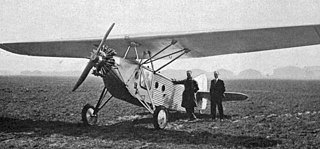Related Research Articles

The Siebel Si 202 Hummel ("Bumble-bee") was a German light sportsplane of the late 1930s. It was an angular low-wing monoplane, which could be powered by a variety of small engines.

The de Schelde Scheldemusch was a single-seat pusher biplane designed in the Netherlands to be easy and safe to fly. It was one of the first light aircraft to use a tricycle undercarriage. Despite a sales campaign in the UK, only six were built, one being briefly tested by the RAF. A single example of a flying boat version, one of the smallest of this class, was also built.

The Praga E-210 was a four-seat, twin-engined touring aircraft built in Czechoslovakia in the late 1930s. It had an unusual pusher configuration. Its tail unit and undercarriage were modified significantly before World War II and after the war a more powerful version designated E-211 was flown.
The Indraéro Aéro 30 is a single seat, single engined sports biplane designed in France in the late 1960s. Only one was built.

The Scheibe SF-27 Zugvogel V is a single-seat Standard Class sailplane, designed and built in Germany in the 1960s. A motorised version was also produced. Significant numbers remain active.

The SAIMAN LB.2 was an unconventional Italian two seat cabin side by side sport aircraft designed around 1937, with a single pusher configuration engine, twin tail booms and an early tricycle undercarriage.

The Coupé-Aviation JC-01 is the first of a series of very similar designs of two seat, single engine sports aircraft, amateur built from plans in France from 1976. These provided a range of engine sizes and undercarriage layouts, but total production was small.
The Briffaud GB-10 Pou-Push was a Mignet style tandem wing single seat aircraft with a pusher configuration single engine. The sole example was built in France in the 1980s.
The IIL IS-9 was a low powered, experimental pod and boom style motor glider, designed and built in Romania in the late 1950s.

The Merville D.63 was a modification of the Druine D.62 Condor with a nosewheel undercarriage, modified fin and French engine. It flew in 1962.
The Dupuy D-40 was a French built, low powered monoplane designed for touring abroad. The only example was used for an uncompleted journey to Saigon.
The Caudron C.570 was a French twin-engine aircraft designed and built by Caudron in the mid-1930s. It was designed to function in multiple roles; as a bomber, passenger transport, paratroop aircraft, cargo aircraft and air ambulance.

The Couzinet 20 was a low power, three-engined aircraft designed in France in 1929 for postal duties, though it could have been configured to carry three passengers or as a medical transport. Variants flew with three different engines but only two airframes were completed.

The Mauboussin M.112, M-12 or Mauboussin M.XII was originally called the Peyret-Mauboussin PM XII and was renamed when Mauboussin founded his own company in 1931, ending his partnership with Louis Peyret. It was a French, single-engine, two-seat, low cantilever wing touring monoplane. At least six were built.

The Hanriot H.46 Styx was a French, single-engined, parasol wing aircraft which could equally be configured for training, liaison or ambulance roles; in the latter form it was able to accept a patient on a stretcher. Several different engines were fitted and flown but the type did not reach production.

The Bourgois-Sénémaud AT was a parasol wing, two seat touring aircraft built in France in 1928. Three examples were completed.

The Albert A-10 was a four-seat French transport aircraft which could be rapidly converted into an air ambulance. Two or three examples were built between 1929 and 1932, using at least two different engines, but neither variant reached production.
The AMA, named after its designers, was a one-off motor glider built in Poland in the mid-1930s. Its development was abandoned after early tests revealed incurable engine-mounting vibration problems.

The Couzinet 30 was a light transport aircraft / mailplane designed and built in France in 1930 at Société des Avions René Couzinet.
The SCAL FB.30 was a French twin boom, pusher configuration, two seat civil sport and touring aircraft designed by Antoine Bassou in the mid-1930s. Three, with different engines, were built and flown.
References
- 1 2 "Die Meind-van Nes A XV oder WN 16" (in German). Retrieved 10 July 2016.
- 1 2 3 4 5 6 Nowarra, Heinz J. (1988). Die Deutsche Luftrüstung 1933-1945. Vol. 4. Koblenz: Bernard & Graefe Verlag. pp. 43–7. ISBN 3-7637-5464-4.
- 1 2 3 4 "The Meindl Wn16 (figure caption)". Flight . XLI (1728): 49. 15 January 1942.
- ↑ "Aircraft production in Austria" . Retrieved 10 July 2016.
- 1 2 "WNF WN-16" (in Russian). Retrieved 10 July 2016.
- ↑ Keimel, Reinhard (2003). Luftfahrzeugbau in Österreich : von den Anfängen bis zur Gegenwart : Enzyklopädie (in German) (1. Aufl. ed.). Oberhaching: Aviatic-Verl. ISBN 978-3925505782.